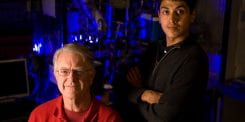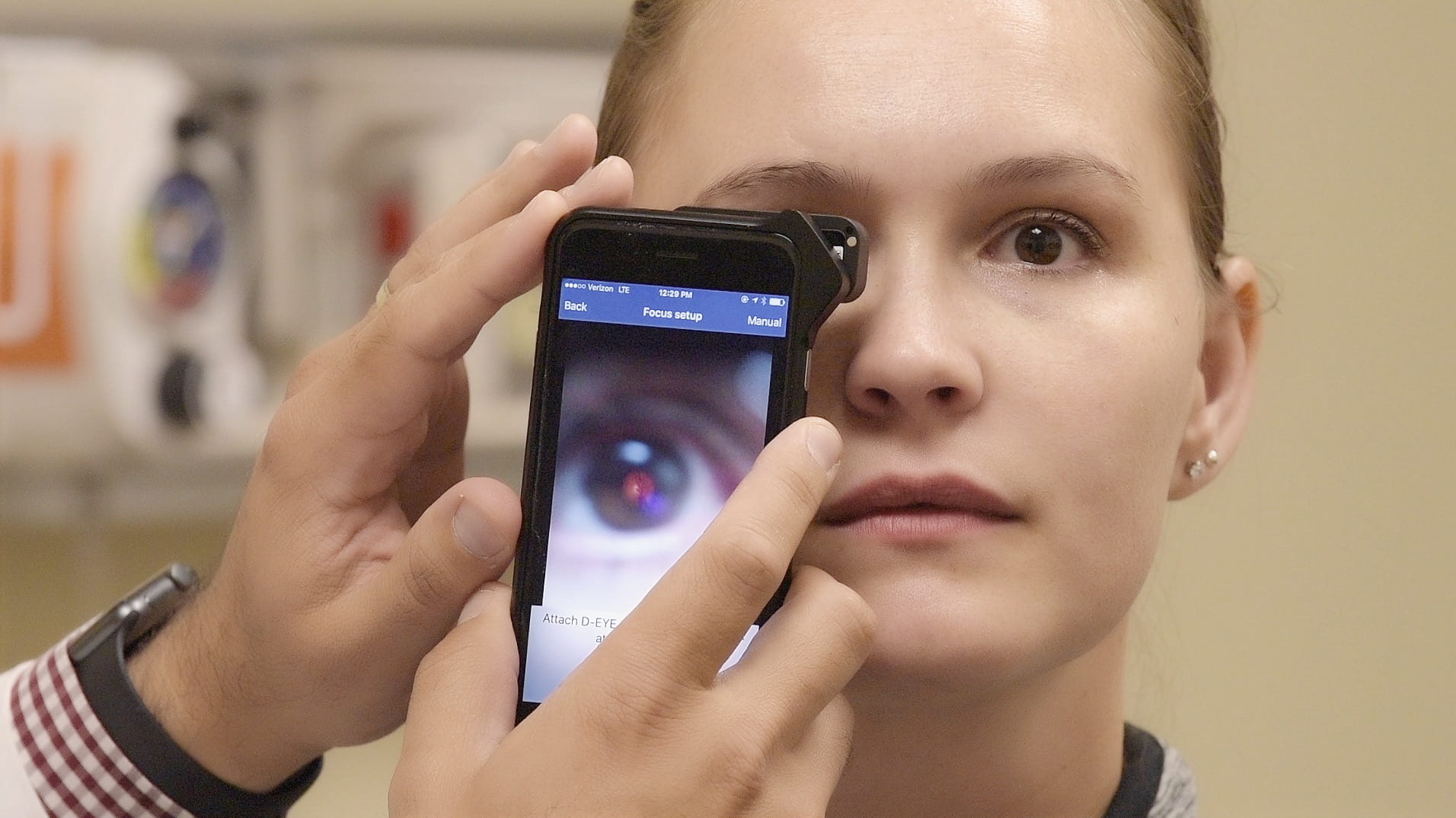East meets West
UCI researchers using high-tech tools are gaining insight into how the Eastern practice of acupuncture works. New medical treatments may result
A 2,000-year tradition of Eastern acupuncture is meeting the rigorous analysis of Western medicine, a collision likely to produce valuable new knowledge about how the human nervous system operates.
Acupuncture not only works, UCI researchers are coming to believe, but an understanding of how it works will lead to new medical treatments. Patients might be able to control their own blood pressure and hormone levels. Doctors will have new tools to treat heart disease and the aftereffects of heart attacks and stroke. Pain, including the phantom pain of a lost limb, could be alleviated. Even psychiatric disorders might eventually be helped by new knowledge now being gathered.
UCI researcher and Department of Medicine Chair John Longhurst and visiting professor Peng Li have shown that acupuncture can activate endorphins to lower blood pressure and treat some types of heart disease.
Another UCI team has shown that acupuncture triggers brain responses that correspond to sensory stimulation. Physicist Zang-Hee Cho and neuro-opthalmologist Edward K. Wong have used functional Magnetic Resonance Imaging (a method of imaging activity in specific brain regions, also known as fMRI) to show brain response to stimulation of specific acupuncture points, or acupoints. A point near the little toe prescribed for treating eye problems, for instance, fires neurons in the same part of the brain that responds to vision. Another acupoint on the hand, prescribed for ear-related disease, triggers brain activity in the same location that responds to sound.
Acupuncture posits a theory of the human body as a network of “meridians” through which circulates a form of energy called qi(pronounced “chee”). Needles inserted at precise points in this network will influence the flow of qi and, by bringing the body back into balance, effect a cure. It requires practitioners to determine whether patients are cool and calm “yin” people or warmer, active “yang” people, because the same procedures will produce opposite results on the two.
For both teams of researchers, interest was triggered when East literally met West.
Longhurst was visiting the University of Shanghai in 1992 when Li approached him and asked if he would be interested in studying acupuncture. “I said no,” Longhurst said. “I thought it was voodoo, or that maybe we were seeing a placebo effect.” But Li talked to Longhurst again on his next visit in 1994, and by 1995, Longhurst had agreed to collaborate.
The two now have published several papers on results of their animal experiments using acupuncture, one of which demonstrates that acupuncture stimulates the creation of endorphins, the body’s natural painkiller. The experiment has verified that acupuncture does indeed alleviate pain but, more important, it has shown how.
The work has made a convert of Longhurst.
“I now believe there is reality [to claims made for acupuncture] because I’ve seen it in my lab,” he said. He sees possibilities he wants to share with other physicians, which is one reason he has helped organize UCI’s Susan Samueli Center for Integrative Medicine. “I want to provide an understanding of acupuncture in a framework that would be understood and potentially accepted by Western scientists and physicians.”
Rigorous science leading to a clear understanding of mechanism is the strength of Western medicine — and a weakness of Eastern medicine. The lack of “proof” in Western terms is why alternative and complementary medicine have remained marginalized. Li, working in Longhurst’s UCI research lab, said that in approaching Longhurst, he had been seeking the help of a Western scientist specifically because acupuncture needed the scrutiny of Western scientific method. Li says that as a young doctor — he is now 67 — the need for scientific proof was stressed to him. “My old professor asked us to try to study the method of acupuncture,” Li said. “We know it cures many diseases, but what is the mechanism?”
On the other hand, Li says, Eastern medicine has something important to contribute to the West: the concept of treating the human body as a unified whole. In the West, he says, “the doctor looks at the patient not as a whole patient, but just as a heart muscle. They perform tests on the heart muscle, give medicine for the heart muscle. Chinese medicine looks at the whole person, and advises patients to balance themselves.”
Li believes that “every science should learn from different countries and different sources. Then you can develop. China stays backward because it is closed. That’s why the United States is so advanced — because it accepts most things from around the world.”
Physicist Zang-Hee Cho’s use of fMRI to study acupuncture also was prompted by a visit to the East — and, before that, by a fall he suffered while hiking. Cho wasn’t seriously hurt, but he continued to have back pain until he gave in to his family’s urging to try acupuncture. Fifteen minutes and $40 later, he was pain-free — and very curious. Something obviously had worked, but what?
On his next trip to Korea, during a 1996-97 sabbatical, Cho decided to stop in at an acupuncture training school and ask questions. “I asked one of the students, ‘I’m very curious how acupuncture works.’ He explained yin and yang, this and that.” Cho didn’t understand it, so he tried asking questions that would relate to the work he had been doing, using fMRI to study how the brain handles vision. “Which acupoint will cure eye disease?” he asked the student. “He pointed, and I said, ‘Let’s try it!'”
Using fMRI equipment, Cho performed his first experiment that showed the acupoint the student had indicated did indeed produce a response in what Cho knew was the part of the brain that handles visual information. “I was very excited,” he said. “I came back and talked to Dr. Wong.”
Edward K. Wong, an associate professor and research neuro-ophthalmologist at UCI, has worked with Cho for more than ten years, obtaining with him two joint patents on MRI and Positron Emission Tomography (Cho is one of the inventors of the original PET technology). Wong describes their collaboration: “I’m the physician, he’s the scientist.”
The two designed a series of experiments extending Cho’s original approach. Twelve volunteers were positioned before a flashing checkerboard pattern and their brain responses to the visual stimulation were recorded by fMRI. The twelve then had acupuncture needles inserted in acupoint UB67, prescribed for treating the eyes and located near the little toe, and their brain responses were recorded by fMRI. The two stimuli produced identical patterns of brain responses, which didn’t happen when the needle was moved a few centimeters away. Cho and Wong also found that the volunteers fell into two groups in the intensity with which their brains responded: yin and yang, Cho speculates.
In another experiment, volunteers listened to music and were stimulated at auditory-related acupoint SJ5, located on the hand. Again, the same areas of the brain lit up for both.
To Cho, the experiments clearly indicate that acupuncture’s “qi” and “meridians” are really just the peripheral nervous system, and that the important response takes place in the brain. “When you break your finger and you can’t move it, it’s something wrong in here,” he said, tapping his head, “not in here,” holding up a bent finger. The brain, in other words, responds to the damage and pain of the broken finger and issues an “executive decision” that it will not move. Something like that must be happening with acupuncture, he thinks. But again, how? Does the brain interpret an acupuncture needle as a tiny assault, and route the information to the survival-tools limbic area, and does the limbic system then pass the alarm to the hypothalamus, in effect notifying it to release the proper mix of hormones to deal with the problem? That, in extremely simplified terms, is Cho and Wong’s current operating theory.
The two researchers are excited by different aspects of this work. Wong loves the idea that, given what we know now, it doesn’t make any sense. “There is no known pathway from the small toe to the back of the brain,” Wong says. “If we’re starting to find new pathways to the brain that were not known before, not only do we have an understanding of alternative medicine and acupuncture, but we might develop a new understanding of the neural anatomic pathways, which are very difficult to see in a human because you can’t take a human apart.”Cho takes what Wong describes as a “total system” approach. The physicist is absorbed by the mechanism of acupuncture. How does it work? What is an acupuncture signal? How does it travel? Where does it go?
“Acupuncture, is it pain? What is it?” Cho asks. Maybe the acupuncture signal is basically pain, because the needles the old-time Chinese acupuncturists used were really big and really hurt, Cho said, and there is some evidence that they worked better. But is it really necessary for acupuncture to hurt, or is precision the key?
If finding precisely the right acupoint is the critical thing, fMRI feedback will help enormously. “Now we have something like 300 acupoints,” Cho said. “Some of them overlap, some of them are nonsense, and some of them are real. Let’s find out, in a scientific way, so we don’t need to put 20 needles in — maybe just one.”
To the two scientists, now is the time to finally solve the 2,000-year-old acupuncture puzzle. Functional MRI, which has given people the ability to monitor a functioning brain, became available in 1992. And UCI, with its strength in neuroscience, is the right place, they think.
Cho, Wong and Longhurst all acknowledge that, professionally, they’re taking some chances by working on acupuncture; mainstream medicine can, and occasionally does, look askance. Cho feels that with his age (63) and professional standing, “I’m not afraid of such a thing.” Longhurst thinks it’s a good thing that medicine has such high standards of proof, but also, “I believe strongly that we need to be constantly skeptical but searching for new answers.”
As a younger scientist, Wong says he’s content to go out on a limb with Cho because he finds the research “very exciting.”
“In academic medicine, you have to take chances,” Wong said. “This is not a very accepted way of looking at medical treatment but, when you look at it, people like Dr. Longhurst — who is in the forefront of his area of cardiovascular medicine — is taking a chance, too. If you don’t take a chance, you’ll never pioneer. You end up doing what everyone else has done.”

